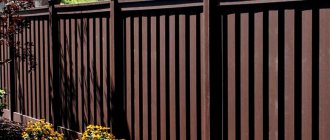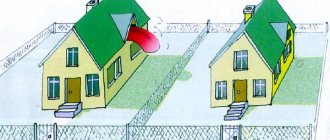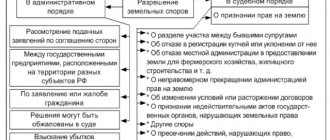What kind of fence can a country house have according to the law?
Many Russian citizens are faced with the problem of building a fence around their summer cottage. This procedure is labor-intensive, costly, and disputes with neighbors may arise. To install fences around your property, you need to know the legal regulations. If a fence is installed at the wrong height or structure, dissatisfied neighbors may complain by filing a lawsuit.
What law regulates the procedure for installing a fence in a country house?
In the Russian Federation there is no law on installing a fence, there are only rules and recommendations that owners of summer cottages must adhere to. Although many resort to the provisions of the law on personal subsidiary plots.
When installing a fence around your summer cottage, you must follow the provisions of special rules SNiP 30-02-97. SNiP are the building codes and regulations of the Russian Federation. The provisions of the legislative act contain conditions for the planning and development of the territories of gardening associations of citizens, buildings and structures. The document under consideration is the main document for the development of territorial construction standards for the constituent entities of Russia. (Law 66 Federal Law in the latest edition can be found here:)
According to the law, in order to install a fence, it is necessary to determine the boundaries of its installation, the height and the material of which it will consist. Next, you should coordinate your chosen parameters with your neighbors whose summer cottages border yours. After talking with neighbors, you should apply for a building permit from the department of urban planning and architecture. According to the law, if the owner of a corner plot wants to install fences, then in any case he will have to contact an architect.
When installing a fence, you must maintain a distance from the fence to objects located on your territory and on the territory of your neighbors. According to the law, you need to keep the following distance:
- from the house to other residential facilities - at least 3 meters,
- from buildings with poultry or small livestock - at least 4 meters,
- from other types of buildings - at least 1 meter,
- from green spaces of average height - 2 meters,
- from tall trees - 4 meters.
It is important to know how to correctly measure the distance to install a fence. The measurement is carried out starting from the wall of a residential building or basement. If there are protrusions less than 50 cm in size, the distance is calculated from the wall of the house. If the protrusions are more than 50 cm, then measurements are taken from them.
Each owner of a summer cottage has the right to choose the color of the fence and the material from which it will be built. However, we should not forget about fire safety rules. According to the provisions of SNiP 30-02-97, the following rules must be observed:
- The fence can be built at a distance of 6 meters from buildings constructed of non-combustible substances. For example, from concrete or brick,
- The fence can be installed 8 meters from buildings built from non-combustible substances, but with the presence of wooden elements,
- Fences should be installed around the summer cottage at a distance of 8 meters from buildings built from flammable and non-combustible materials,
- Fences can be installed 15 meters from structures made entirely of wood.
All nuances regarding the distance of building a fence from construction sites are specified in SNiP 30-02-97. To download the latest version of the document, follow the link.
Maximum fence height at a summer cottage
Many owners of dacha plots are interested in the question - what kind of fence can a dacha have? Building codes require that all neighbors' fencing be provided with minimal shading. The height of such lattice or mesh fences should be a maximum of 1.5 meters. It is allowed to install a higher fence on the side of the street and driveways. The one and a half meter height is determined by authorized persons in order to protect the interests of neighbors.
The new law on the height of the fence has not yet been issued, so all owners of summer cottages and private houses must refer to SNiP standards when installing fences.
The height of the fence on the site may be more than 1.5 meters if the following situations occur:
- if the members of the partnership decide to set a different height,
- if the owner of the summer cottage has reached an agreement with the neighbors to increase the height of the fence,
- if the boundary is set back from the neighbor's plot, which will allow it not to darken the neighbors' territory.
By law, the installation of fences exceeding 1.5 meters must be coordinated with neighbors and special institutions. Rules may vary by region.
Dimensions of fences between neighbors
When installing a fence on a summer cottage in accordance with the law, it is important to take into account the material from which the fence structure will consist. To build fences around a summer cottage, the following materials are used:
- corrugated sheets,
- slate,
- concrete,
- brick,
- tree,
- sheet metal,
- net,
- polycarbonate panels,
- other materials.
A blind fence between dacha plots is not allowed. Dacha owners have the right to install such a fence on the street side, subject to the appropriate permission.
Mesh and lattice fences must transmit at least 50% of sunlight directed at an oblique angle. Similar requirements have been introduced for the normal growth of agricultural plantings.
As for the size of the fences, the thickness can be any. The size depends on the preferences of the owner of the dacha area and on the material from which the fence will be built. If the thickness of the structure is more than 5 cm, then it can only be located on the owner’s property. To install a structure on the boundary, it is necessary to obtain the consent of the neighbors.
Where can I complain if my neighbor installed a fence illegally?
Before starting the process of erecting a fence around the perimeter of a summer cottage, it is better to discuss your actions with your neighbors. The dimensions, material, installation location and height of the future structure should be discussed. To avoid conflict situations in the future, it is recommended to conclude a written agreement with signatures. Such an agreement will have legal force.
If a fence is installed or has already been installed on a neighbor’s property that does not comply with generally accepted standards, then the citizen whose rights have been infringed has the right to file a complaint. Initially, it is better to try to resolve the controversial situation peacefully. If you cannot reach an amicable agreement, you should go to court.
To go to court, you must present a statement of claim and documents confirming the violation of SNiP. Required documents:
- paper confirming land ownership,
- cadastral plan of land area,
- boundary plan,
- plan diagram of both sections,
- other documents at the request of court officials.
A court verdict can be made in favor of the plaintiff or the defendant, it all depends on the evidence of violation provided. Before going to court, it is better to settle the dispute out of court. This method of conflict resolution will help save money on legal costs.
Procedure
To draw up documents confirming agreement with neighbors on the selected fence design, you need to follow the following procedure:
- Find out the requirements for fences and barriers depending on the location of the land plot. To do this, you need to contact the management of the partnership or the local administration.
- Determine the boundaries of your site according to the boundary plan, within which the fence should be installed. This will allow you to clearly see where your own land ends and your neighbor’s begins. If necessary, you need to order land surveying.
- Discuss with your neighbors all the parameters of the future design: exact location (can be marked with pegs), height, material, transparency. Perhaps they will make other proposals that will suit both sides.
- Record the agreements reached in writing.
If a fence needs to be installed on the border of two or three adjacent plots, then the appropriate number of agreements should be drawn up.
Once consent to install a fence between neighbors has been issued, you can begin to obtain a building permit from the architectural or urban planning department of the municipality. The presence of this document will protect the owner of the site from administrative liability for illegally constructed objects or requirements for dismantling the structure.
We recommend reading:
- Distance from the bathhouse to the fence and neighbors' house
- Distance from tree to neighbor's fence
The height of the fence between neighbors: what does it affect and what are the standards?
Having your own home is convenient. On the site you can build not only a huge house, but also a garage, plant a flower garden, and on weekends spend time not in a stuffy apartment, but in a gazebo, barbecuing and enjoying nature.
However, to make living in a private house a joy, it is worth building a fence. Moreover, you need to protect yourself not only from the prying eyes of those around you on the street, but also from your neighbors. To ensure that the fence does not have to be dismantled several months after installation, you need to know and comply with all legal requirements.
Fence installation: legal requirements
separate law in Russia that sets out the rules for installing fences. But the requirements for fences between neighboring properties can be found in building codes and regulations.
What the law says
First of all, I want to clarify that according to the Land Code of the Russian Federation, all lands are divided according to their intended purpose. The Federal Law “On the conduct of gardening and vegetable gardening by citizens for their own needs, and on amendments to certain legislative acts of the Russian Federation” No. 217 of July 29, 2017, divides land plots, but on the basis of the permitted type of use: lands intended for agricultural use and lands of populated areas. I would like to say that according to the latest edition of SNiP, the dimensions and characteristics of fences in areas intended for agricultural use are indicated only as recommendations. Therefore, the charter of the partnership and cooperative to which the home ownership belongs will determine which fencing should be in place and which should not be. As for the lands of populated areas, the parameters of the fences are determined by the local administration.
I advise everyone to read my colleague’s article about whether it’s worth hiring a designer when renovating an apartment?
And now the most important thing is, why will a fence be banned without the consent of a neighbor? But because, according to the legislation of the Russian Federation, the installed fence should not interfere with ventilation and darken the neighboring land plot. Such violations allow the injured party to file a claim in court.
Land issues
Fence between neighboring plots. Rules for installing a fence according to SNiP
Fence between neighboring plots. Rules for installing a fence according to SNiP
When solving land use issues, the correct installation of a fence between areas is of great importance. If established standards are violated, the owner of the site may be held administratively liable, and even forced to demolish the fence.
- Fence between neighbors: legal fencing of a site in accordance with all SNiP rules
Regulatory regulation of fencing installation parameters
When installing a fence and choosing its design, you should be guided by separate building codes and regulations (SNiP) related to planning the development of urban and rural settlements, territories of gardening (dacha) associations of citizens, territorial building codes (TSN), as well as land use and territory development rules, accepted by local authorities.
In many sources, which discuss the issue of acceptable parameters for site fencing, reference is made to SNiP 30-02-97 (2001) “Planning and development of territories of gardening (dacha) associations of citizens, buildings and structures.” This means that with regard to planning sites for individual housing construction (IHC) and running personal subsidiary plots (LPH) in rural and urban settlements, SNiP 30-02-97 does not apply, unless otherwise specified in the territorial building codes.
SNiP 2.07.01-89 applies to the planning and development of urban and rural settlements. Requirements for the height and other parameters of fences may also be contained in the regulatory documents of local authorities. Before installing a fence on your summer cottage, you should contact the board of your gardening association.
- The height of the fence between neighboring areas
The greatest number of disputes arise due to the height of the fence between neighboring areas. The fence can shade the neighbors' beds; the absence of a fence leads to damage to the garden, flower beds and other property by pets running from one area to another.
What fence height between neighboring areas is considered optimal?
SNiP 30-02-97 states: “Individual garden (dacha) plots, as a rule, should be fenced . Fences for the purpose of minimal shading of the territory of neighboring plots should be mesh or lattice with a height of 1.5 m. It is allowed, by decision of the general meeting of members of the gardening (dacha) association, to install blind fences on the side of streets and driveways.”
But in practice, the height and material of the fence often do not comply with established standards. This may happen for the following reasons:
- At the general meeting of the members of the partnership, it was decided to establish other acceptable parameters for fencing,
- the neighbors agreed among themselves to install a fence of a different type and height between their plots,
- to increase the height of the fence and prevent shading of the neighbor's property, an indentation was made from the boundary,
- A higher fence was installed without any approval.
A blind fence from the street is usually installed up to 2.2 m high. This requirement is related to ensuring normal lighting of streets, driveways and sidewalks. With regard to sites for individual housing construction and private plots in urban and rural settlements, these requirements apply only if this is expressly provided for in territorial building codes. In other cases, you can install fences of almost any height, the main thing is that they do not violate the legitimate interests of the owners of neighboring plots.
- Distances between the fence and other objects on the site
How to write?
Before you begin drawing up a conciliation document, you should consider the following recommendations for its preparation:
- It must be in writing (printed or handwritten) and cannot be considered provided only from the words of neighbors.
- It is provided only by owners of neighboring plots whose interests may be affected by the construction of a fence. It cannot be issued on behalf of their family members, tenants or persons occupying the territory on other grounds.
- Accurate information about the construction initiator, his neighbors, and the land plots themselves is indicated, which will allow them to be easily identified if necessary.
- The date corresponding directly to the date of preparation or signing is indicated.
- It is secured by the personal signatures of all persons indicated in the document.
To give the document greater legal weight, it is recommended to have the signatures certified by a notary. In this case, the neighbor will have no reason to retract his words (for example, to claim a forged signature or come up with other excuses).
Contents of the document
The current legislation does not provide for a specific form and requirements for the content of consent from neighbors. However, the document should include the following information:
- Full name, passport details of the owners.
- Addresses of each site.
- Documents confirming the parties' ownership of real estate.
- The fact that neighbors consent to the construction of a fence, indicating its location and specific parameters.
- Additional conditions (for example, sharing the costs of installing fences, etc.)
- Details of witnesses (if they are present when signing the document).
- Date of compilation and personal signatures of all parties present with a transcript.
Norms and requirements for fencing at the individual housing construction site
When purchasing a plot of land, any owner necessarily plans to erect a fence. The fence not only marks the boundaries of the site, it also protects the owner from intrusion by unwanted persons and from prying eyes.
A beautiful fence can brighten up any yard. However, when building a fence, it is important to know the list of rules in order to avoid conflicts and claims in the future.
Standards governing the construction of a fence on a private housing construction site
At the very beginning, before construction, it is important not to be lazy and contact local municipal institutions. All documents regulating the rules for site development are contained in the local administration, whose employees can connect you with a specialist in the field of architecture and urban planning.
special document regulating the rules for constructing a fence between plots in our country.
If you want to find out how to solve your particular problem in 2021, please contact us through the online consultant form or call :
All basic recommendations and rules can be found in SNiP (building codes and regulations).
Most often, SNiP 30-02-97 is used to plan the construction of buildings on an individual housing construction site, since it most fully discloses the basic rules; local municipalities sometimes simply repeat its provisions in their documents.
Basic requirements for fences for individual housing construction
There are two types of fences on the site: an external fence, separating the site from the road, and an internal fence, erected between neighboring sites.
Construction of an external fence
When constructing an external fence, the following rules must be observed:
- the fence should not rise more than 2.2 m , otherwise the building will interfere with normal street lighting at night,
- the construction of “blind” fences is allowed,
- the fence should not pose a threat to passers-by; for example, if the structure contains pointed elements, it is required that their ends be directed vertically and not towards the roadway. It is impossible to supplement the fence with barbed wire located at the height of human height,
- when installing a strip foundation, the installation of drainage pipes is required; with a solid foundation, you can do without wastewater drainage,
- if the entrance gate is located at a distance of less than one and a half meters, it should open inward so as not to interfere with pedestrians,
- When choosing the color of the fence, it is recommended to consult with the local administration.
Do you work in the public sector and don’t know how to correctly calculate your long-service bonus? Our article will help you with this!
If you want to find out how to solve your particular problem, please contact us through the online consultant form or call :
If you resign of your own free will, then you will find the material on payments upon dismissal of this type useful.
Construction of an internal fence
When constructing an internal fence, the following is required:
- according to SNiP requirements, the fence separating two adjacent sections must be transparent (mesh or lattice),
- the height of the fence can reach 1.5 m, with a blind construction option - 0.75 m. These requirements suggest minimizing shading of the territory of the neighboring plot,
- if the thickness of the fence is more than 5 cm, then the building must be erected on the owner’s territory,
- if the fence is erected on the initiative of only one owner, then the logs should be located on the side of his site, as well as decorative elements,
- a hedge is possible only with the consent of the neighbors.
The distance from the fence to the buildings is also specified in SNiP:
- the distance between the fence and any building on the site must be at least a meter,
- trees and bushes up to 1 m are recommended to be planted at the same distance from the fence, tall trees from 4 meters are recommended to be planted at a distance of more than 4 meters,
- from the fence to buildings where small livestock and poultry are kept should be at least 4 m.
SNiP also covers fire safety issues:
- if the fence is made of non-combustible materials, for example concrete or brick, then the distance to the buildings should be 6 meters,
- the wooden fence should be 15 m apart,
- when combining flammable and non-combustible materials, the fence can be placed at a distance of 8 m.
Dispute Resolution
The best solution to a dispute is to prevent it. You should always try to find a compromise with your neighbors, because litigation will not benefit anyone.
Any agreements must be recorded in writing.
If either party has violated the law or categorically refuses to comply with it, then it is worth taking decisive action - filing a lawsuit.
Let's look at solutions to common situations.
What to do if neighbors are against installing a fence
It is allowed to fence off the site with a fence if you step back from the boundary at least 1 m. At the same time, order and document the survey services performed, take photographs of the survey process and step-by-step construction.
If neighbors want to challenge the correctness of the land surveying procedure, request an examination. The cost of the examination is always paid by the losing party.
In the event that neighbors arbitrarily try to demolish the fence without any legal grounds, you can safely call the police and file a lawsuit for compensation for damages caused.
Is it possible to build a fence without asking your neighbor?
There are two answers to the question here:
- No. The opinion of the other party is always taken into account. Therefore, when the owners of a neighboring plot are against the construction of a fence, it is better not to provoke a conflict and refuse construction.
- No. You still need to ask. But even if the answer is negative, the law allows the installation of a fence up to 1.5 m high from chain-link or wooden picket fence.
If your neighbor wants to challenge the legality of erecting a fence in court, it will not work, since the law will be on your side.
What to do if a neighbor violates the requirements
There are several options for solving this situation:
- If the estate is part of TSN, file a complaint with the chairman of the partnership.
- State the essence of the complaint in writing and try to contact the local Rosreestr, which is responsible for land supervision. This applies to cases where the fence touches part of your estate.
- If the first two methods failed to solve the problem, then only then prepare a lawsuit. Before serving, you need to prepare thoroughly. Collect evidence that the fence installed by the neighbor threatens the lives of people on the site, reduces the level of harvest, and interferes with normal ventilation. Provide a development plan, according to which it will be clear that the fence partially extends into your territory.
The last option for resolving the dispute is the most expensive, and it should be resorted to only in extreme cases. Often, an expensive forensic examination is carried out, which is paid for by the losing party.
When filing a claim, you must try to prove that the neighbor violated SP 53.13330.2011, article of the Civil Code “Protection of the owner’s rights from violations not related to deprivation of possession.”
In practice, it is very difficult to prove that the installation of a fence violated the rights of the owner. Even if there is evidence, there are cases where a claim is rejected.
In order not to waste time, money and effort, you need to try to resolve all issues peacefully.
If you have violated the rules for installing a fence
This threatens, at the very least, a quarrel with neighbors. It is necessary to try to come to an agreement with the other party as quickly as possible. If the neighbors do not want to make concessions, then the worst case scenario is for them to file a lawsuit and demolish the illegally installed fence.
This happens extremely rarely, since this requires an impressive evidence base, which will indicate that there is a threat to the lives of people living in the neighboring area.
Another course of events is that a written agreement has been concluded with your neighbor to build a non-standard fence at your expense. But suddenly the neighbor sells the estate and the new owner does not agree with this decision regarding the fence. He has every right to challenge the installation of the fence in court, citing as arguments that the fence shades the residential building and prevents trees or shrubs from growing normally.
Try to reach a compromise peacefully and compensate for moral damage in monetary terms.
Fence between neighbors - reliability and beauty according to the rules
An original solution attracts attention
Every person who has his own plot of land has faced the issue of installing a fence. In addition to the main points on the choice of material, cost and production time, there are other important issues. For example, are there certain standards for installing a fence between neighbors? How are issues between neighbors settled, who is right and who is wrong? There are actually many such problems. Moreover, the larger the population of the village, the more severe they are.
A fence in a village between neighbors can be built by either party, without any restrictions on height or quality of material. The market of modern materials today offers such a replacement for the classic wooden option as corrugated board .
This material has the following positive aspects:
- quite easy and convenient installation,
- solid structure up to 7 meters in height,
- good sound insulation,
- use of simple tools during installation,
- high durability of the material, with a galvanized coating it can last up to 20 years, and with a polymer coating - 50 years or more,
- price affordable for most consumers.
Norms and rules for the construction of fences
An important question for a law-abiding citizen: is there a law on fences between neighbors? In fact, there is no such law! There are a number of rules for gardening associations, which are regulated by SNIP 30-02-97 * as amended on March 12, 2001.
Standards for the construction of structures
The rules for erecting a fence between neighbors and land surveying establish the maximum height of the fence separating neighboring plots of no more than 1.5 meters. The minimum distance from the house to the fence is also specified in the set of building regulations.
People often ask whether it is possible to install a blind fence on the border of two properties? According to the regulations, such a fence must be translucent, that is, transparent in the form of a mesh or lattice. A solid fence is allowed to be installed only on the side of the roadway.
Continuous fence option between neighboring areas
If you and your neighbors have agreed on the fence height you need, which is higher than recommended, it is best to formalize this agreement in writing. In the future, such a written document will have legal force.
It is important to understand that SNIP is not a law, but only a recommendation , on the basis of which appropriate decisions should be made. So, for example, in different regions the local administration has adopted different standards for the construction of heights for fences in adjacent areas. For the Volgograd region this is 2.2 meters of translucent fencing and 0.75 meters of solid fencing.
In order to find out the height recommended by the rules of individual housing construction (individual housing construction) in your region, you should visit your local government authorities.
Fire safety standards for the construction of fences
If the issues of choosing the height of the fence and its transparency can be ignored or disputed, then fire safety rules should be taken on faith. Life safety, by definition, is above all rules and regulations.
According to SNIP recommendations, the distance between neighboring houses is:
- 6 meters for non-combustible structures made of stone, brick and concrete,
- 8 meters for the same structures, but with wooden floors,
- 15 meters for completely wooden buildings,
- at least 8 meters with various combinations of flammable and non-combustible construction materials.
What’s interesting is that the distance between buildings on the same site is not standardized and is not fixed by rules. Just as there are no recommendations establishing the distance between neighbors’ fences.
The simplest fencing option in the private sector
The instructions for a number of aspects of sanitary and household rules recommend:
- the distance from the house to the neighboring plot should not be less than 3 meters,
- the distance from various outbuildings to the neighbor’s fence must be at least 1 meter, and the slope of the roofs must be directed in your direction,
- plant shrubs at a distance of more than 1 meter, trees of medium height - 2 meters and tall trees - 4 meters,
- locate toilets, cesspools, buildings for animals and birds no closer than 12 meters.
Attention! Failure to comply with sanitary, household and fire safety requirements may result in administrative punishment in the form of a fine.
Ways to resolve uncoordinated actions between neighbors
It is advisable to discuss the rules for building a fence between neighbors amicably. Ideally, they should be written down in the form of a contract that will have legal force.
Let’s imagine a situation where there was never any fence between plots in the village, let’s say relatives lived. You got one of the plots, and you plan to fence it.
Who should put up a fence between your property and your neighbor's property? The answer to this question is not regulated by the recommendations of SNIP, and especially by laws. You need it - you install it. If the parties are mutually interested, appropriate mutual actions are taken to jointly install the fence.
Modern installation of a fence between neighbors, carried out in accordance with all norms and rules
What to do if a neighbor’s fence violates all your plans and does not correspond to the accepted height? For example, instead of the permissible SNIP height of 2 meters, a continuous 7-meter fence was installed.
First of all, you should talk to the person and explain your wishes. More than half of all conflicts can be resolved with a simple conversation. At the same time, it is important to speak in a positive manner, without negativity.
If the conversation doesn’t go well and everything remains the same, then you should go to court. The court decision will depend on many factors, and it is not always positive. But it's worth a try anyway.
Various solutions for fencing construction
The rules for constructing a fence between neighbors allow the installation of a structure made of any material. The main thing is that there is no excessive shading, there is a pleasant appearance on both sides, and the structure can withstand any wind loads.
Basic materials that meet these criteria:
- tree,
- Rabitz,
- combination of mesh and corrugated sheeting,
- forged metal fencing.
Wooden fences have long established themselves as practical, easy to install, environmentally friendly and visually attractive structures. Metal fences made from chain-link mesh began to be used a little later, but have found even greater use due to their good price, the possibility of easy DIY installation and great durability.
Option for fencing between adjacent areas
Advice! Any structure, be it made of wood, concrete or metal, will last much longer if carefully treated with special coatings.
Antique interior design has become very popular lately. A fence in the country in the form of a wattle fence made of willow twigs will add a certain flavor to your home. In this case, it is necessary to take into account the compatibility of such a fence with other buildings and plants on the site.
Colorful design of the site
The procedure for approving construction with a neighbor
Agreeing verbally with your neighbors is not enough. The right thing to do is sign a written agreement certified by a notary. Only this document will have legal force in court.
You can ask a notary for a sample agreement. But if this does not turn out to be the case, then it’s okay, because there are no legal requirements for the form.
The main thing is that it contains the following data:
- Passport details of both parties.
- Cadastral numbers of estates.
- Description of the subject of the agreement: construction of a fence on the boundary, dimensions and materials used, type of foundation.
- Who pays the construction costs carries out the work.
- Date and place of creation of the agreement.
- Details of both parties and signatures.
The document is drawn up in two copies, one copy for each party. The agreement is kept for exactly as long as the fence lasts.
For TSN land owners, the approval procedure is slightly different:
- You need to carefully study the organization's charter. This is where the key requirements for installing a fence are indicated.
- Talk to your neighbors about building a fence. If there are no reasons for disputes, then draw up a written agreement.
- At a meeting of TSN members, coordinate your plans with the board, obtain approval for development in writing.
After this, you can begin construction work.
A deviation of even 10 cm from the boundary of the plots can cause quarrels. To avoid conflicts, it would be good to carry out a land surveying procedure.











